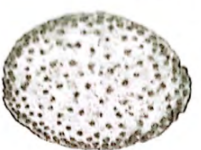INSTRUCTION TO CANDIDATE
- This paper consists of section 3 questions only
- Answer ALL questions
- You are provided by specimen Examine it and answer the questions that follow.
- Make a transverse section through K to obtain two halves From one half of K,squeeze the juice into a clean test tube and label K. Using juice K and the reagents provided, carry out the food the food tests to determine the food present in juice K. (8 marks)
FOOD PROCEDURE OBSERVATION CONCLUSION -
- What is the mode of dispersal for k and J (1 mark)
- Give a reason for your answer (1 mark)
- Cut a transverse section through J. Examine the cut section carefully using a hand lens. Make a drawing of what you observe and label any three parts. (5marks)
- Make a transverse section through K to obtain two halves From one half of K,squeeze the juice into a clean test tube and label K. Using juice K and the reagents provided, carry out the food the food tests to determine the food present in juice K. (8 marks)
- The photomicrograph below represents a certain part of the plant.
-
- From which plant organ was the photomicrograph obtained (1 mark)
- Name the class of plant to which the section in the micrograph belong ( 1mark)
- Give one reason for your answer in (a)(i) above (1 mark)
- On the micrograph above, label the vascular bundle and the cortex
- A response exhibited by a certain plant tendril is illustrated below.
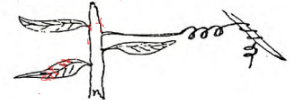
- Name the type of response (1 mark)
- Explain how the response named in (a)(i) above occurs (2marks)
- What is the importance of tactic responses to microscopic animals?
-
- The photograph below represents the lower jaw of a mammal
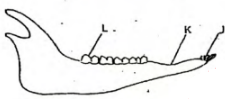
-
- Name the mode of nutrition of the mammal whose jaw is shown (1 mark)
- State one structural and one functional difference between the teeth labelled J and L (2marks)
-
- Name the toothless gap labelled K. (1mark)
- State the function of the gap (1 mark)
- Name the substance that is responsible for hardening of teeth (1 mark)
- Organisms shown in the photograph below are often found in the same ecosystem. Examine them.
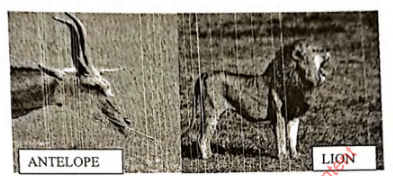
- Name the trophic level occupied by the antelope (1 mark)
- Give a reason for your answer (1 mark)
- Draw a pyramid of numbers for the organisms in the ecosystem. (4marks)
-
- State the relationship between the bacteria found in the root nodules of leguminous plants and the host plant. (1 mark)
- How does the host plant and the bacteria benefit from this relationship (2marks)
-
MARKING SCHEME
- You are provided by specimen Examine it and answer the questions that follow.
- Make a transverse section through K to obtain two halves From one half of K,squeeze the juice into a clean test tube and label K. Using juice K and the reagents provided, carry out the food the food tests to determine the food present in juice K. (8 marks)
FOOD PROCEDURE OBSERVATION CONCLUSION Reducing sugar Put 2cm3 of solution K into a clean test-tube. Add equal amount of Benedict's solution and boil. Blue colour of Benedict's solution turns to green to yellow to orange Reducing sugar present; Vitamin C/ Ascobic Acid Put 2cm3 of DCPIP into a clean test tube. Add solution K into the DCPIP dropwise as you shake. DCPIP decolourises/ disappears Vitamin C/ Ascobic acid present; -
- What is the mode of dispersal for k and J (1 mark)
- Animal;
- Give a reason for your answer (1 mark)
- Fleshy mesocarp/ juicy endocarp/ brightly coloured epicarp
- Scented;
- What is the mode of dispersal for k and J (1 mark)
- Cut a transverse section through J. Examine the cut section carefully using a hand lens. Make a drawing of what you observe and label any three parts. (5marks)
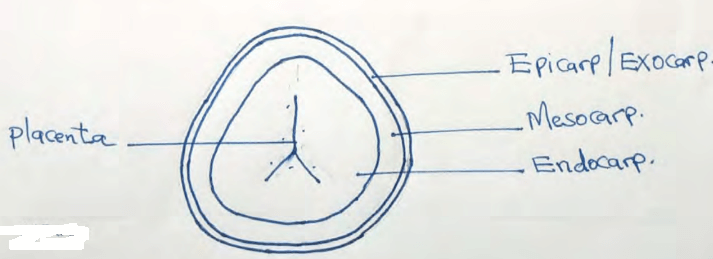
- Make a transverse section through K to obtain two halves From one half of K,squeeze the juice into a clean test tube and label K. Using juice K and the reagents provided, carry out the food the food tests to determine the food present in juice K. (8 marks)
- The photomicrograph below represents a certain part of the plant.
-
- From which plant organ was the photomicrograph obtained (1 mark)
- stem
- Name the class of plant to which the section in the micrograph belong ( 1mark)
- Monocotyledonae;
- Give one reason for your answer in (a)(i) above (1 mark)
- Vascular bundle is scattered in the stem;
- From which plant organ was the photomicrograph obtained (1 mark)
- On the micrograph above, label the vascular bundle and the cortex
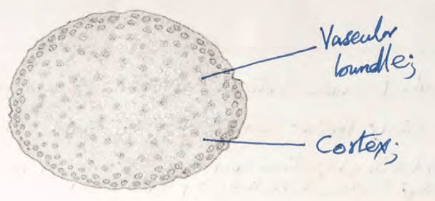
- A response exhibited by a certain plant tendril is illustrated below.

- Name the type of response (1 mark)
- Thigmotropism/ Haptotropism;
- Explain how the response named in (a)(i) above occurs (2marks)
- Contact causes lateral migration of auxins to the outer side of the stem; Higher concetration of auxins on the outerside causes rapid cell elongation and faster growth on the outer side than contact side; hence twisting of the stem.
- What is the importance of tactic responses to microscopic animals?
- Enable organisms to escape from harmful stimuli;
- To seek favourable habitat and resources;
- Name the type of response (1 mark)
-
- The photograph below represents the lower jaw of a mammal

-
- Name the mode of nutrition of the mammal whose jaw is shown (1 mark)
- herbivorous/ herbivory.
- State one structural and one functional difference between the teeth labelled J and L (2marks)
- Structural
- J is narrow/ sharp/ chisel shaped while tooth L is broad/ ridged.
- Functional
- J is used for seizing prey while L is for crushing and grinding food.
- Structural
- Name the mode of nutrition of the mammal whose jaw is shown (1 mark)
-
- Name the toothless gap labelled K. (1mark)
- Diastema;
- State the function of the gap (1 mark)
- Allow space for the tongue to manipulate food during chewing;
- Name the substance that is responsible for hardening of teeth (1 mark)
- Calcium phosphate/ phosphorus/ phosphate. rej calcium
- Name the toothless gap labelled K. (1mark)
- Organisms shown in the photograph below are often found in the same ecosystem. Examine them.

- Name the trophic level occupied by the antelope (1 mark)
- Primary consumer;
- Give a reason for your answer (1 mark)
- It feeds on grass;
- Draw a pyramid of numbers for the organisms in the ecosystem. (4marks)

- Name the trophic level occupied by the antelope (1 mark)
-
- State the relationship between the bacteria found in the root nodules of leguminous plants and the host plant. (1 mark)
- Symbiosis;
- How does the host plant and the bacteria benefit from this relationship (2marks)
- Plant uses some ammonia made by the bacteria through fixation; bacteria obtain shelter and carbohydrates from plant
- State the relationship between the bacteria found in the root nodules of leguminous plants and the host plant. (1 mark)
-
Join our whatsapp group for latest updates
Tap Here to Download for 50/-
Get on WhatsApp for 50/-
Download Biology Paper 3 Questions and Answers - Maranda High Pre Mock Exams 2023.
Tap Here to Download for 50/-
Get on WhatsApp for 50/-
Why download?
- ✔ To read offline at any time.
- ✔ To Print at your convenience
- ✔ Share Easily with Friends / Students

